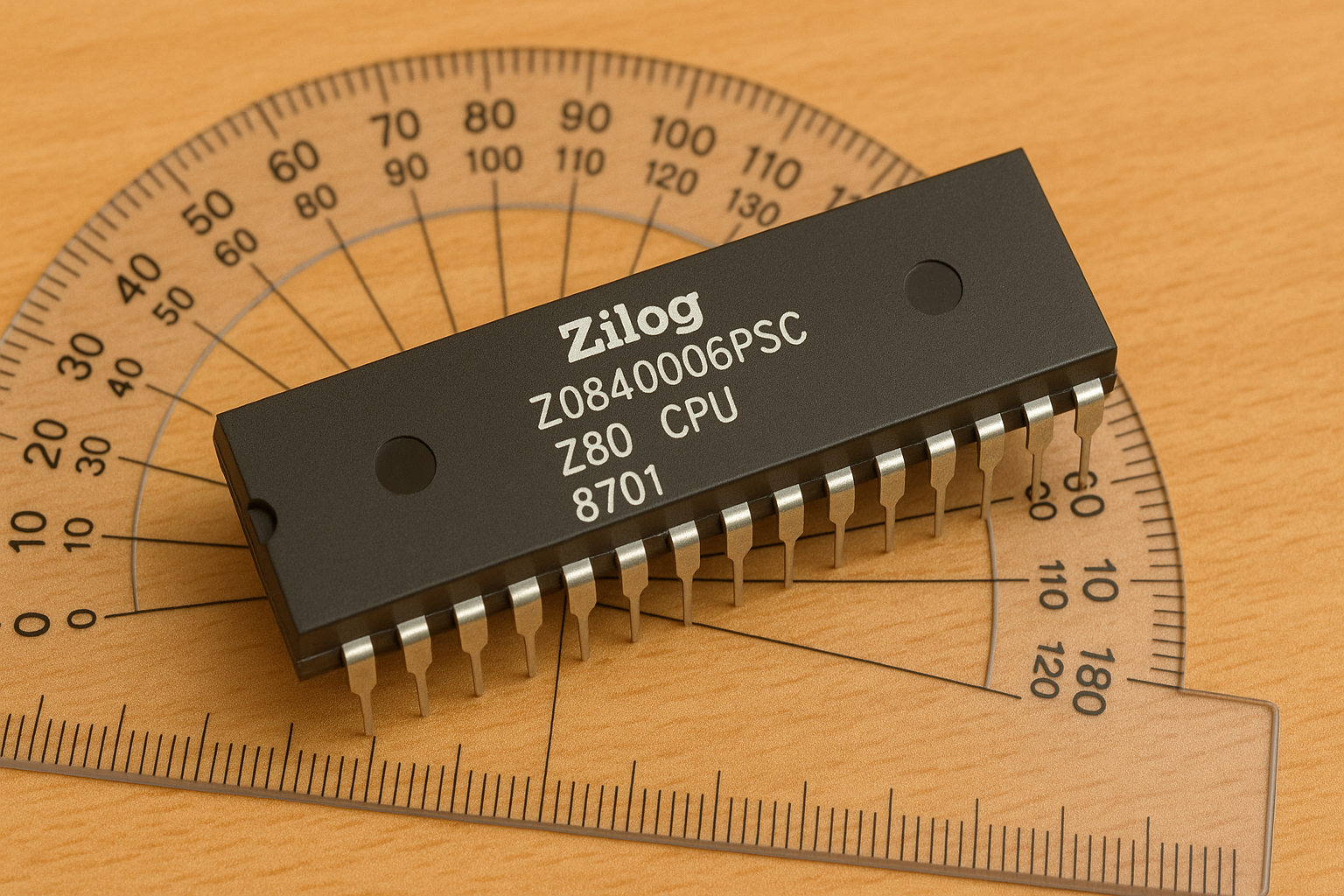From Bytes to Billions: How the ZX Spectrum Laid the Foundations of Modern Algorithms
What We Didn’t Think About – How the "Rubber" Computer Changed the World
Hey, folks! Remember those days when every megabyte of memory seemed like a whole world, and every processor cycle was worth its weight in gold? Of course, you do! After all, many of us are from that very generation that grew up on the pixelated wonders and captivating melodies of our beloved "Speccy"! Among the games released long ago, you can find gems that evoke warm feelings even decades later. And, of course, for the most part, it doesn’t matter what platform these games were released on, what their graphics and sound design were like (or if they even existed at all!).
Today, I want to talk about something that might seem non-obvious but is of colossal importance: how our humble ZX Spectrum, that "rubber-keyed" computer, became a true forge for algorithms that still form the basis of our modern digital world. You’d be surprised, but the very tricks that developers used to squeeze the maximum out of 48 KB of memory and a 3.5 MHz Z80 became the foundation for high-performance libraries and even for the devices that surround us every day, for example, in the world of IoT (Internet of Things)!
Initially, when people remember the ZX Spectrum, they often focus on its limitations: a small amount of memory, a modest processor, and peculiar graphics. However, it was precisely these limitations that, paradoxically, became a powerful stimulus for innovation. Developers didn’t just put up with them; they were forced to think outside the box, invent new approaches, and create incredibly efficient solutions. This need to squeeze the maximum out of every available resource led to the birth of a whole class of algorithms so optimized that their principles remain relevant even decades later. Thus, what seemed like a drawback actually turned out to be fertile ground for the development of fundamental computational methods.
ZX Spectrum: A Survival School for Algorithms
Hardware Features of the ZX Spectrum
The heart of the "Speccy" was the Z80 processor, running at a modest 3.5 MHz. But here’s the most interesting part: this processor couldn’t multiply numbers in hardware! No division or multiplication "out of the box"! All these operations had to be implemented in software, which was incredibly slow. Can you imagine the challenge for game developers, where every millisecond counts?
And what about memory? A mere 48 KB of RAM! That’s millions of times less than modern computers. On top of that, 16 KB of it was allocated for the screen buffer, which further constrained the space for code and data. The 256×192 pixel graphics mode with a palette of 15 colors added its own complexities. But the "funniest" part was the attribute-based graphics: color was not set for each pixel, but for an 8×8 pixel block. This meant that within one such block, there could only be two colors – an INK color and a PAPER color, plus brightness and a flash attribute. No hardware sprites, no smooth scrolling! Everything had to be drawn and moved in software, pixel by pixel, byte by byte.
How "Flaws" Became a Catalyst for Engineering Ingenuity
These limitations were not a sentence, my friends, they were a challenge! They forced developers to think outside the box, to squeeze the maximum out of every bit and every clock cycle. It was a real school of optimization, where every byte and every instruction mattered.
For example, without hardware multiplication, ZX Spectrum developers had to create their own software implementations of this operation, often using a series of additions and bit shifts. This required a deep understanding of the Z80 architecture and the ability to write the most efficient machine code possible. Similarly, when working with graphics, where there was no hardware support for sprites or scrolling, every graphical element had to be drawn and moved manually, byte by byte. This led to the development of sophisticated algorithms for fast screen updates, minimizing artifacts, and making effective use of the limited palette. Such conditions forced developers not just to write code, but to create fundamental computational methods that are now built into hardware or high-level libraries.
Why Standard BASIC Couldn’t Keep Up, and Why Integer Computations Became a Necessity
ZX Spectrum BASIC, while an excellent starting point for many of us, had one serious problem: it used floating-point for all numerical operations. And this wasn’t just slow – it was imprecise! "Numbers are stored to an accuracy of about nine and a half digits," the manual tells us, and provides examples where 1e10+1-1e10 yields 0 instead of 1. Can you imagine the pain for a game developer, where the precision of coordinates or physics is crucial?
This fundamental limitation of BASIC meant that for serious applications, especially games that required high performance and accuracy (e.g., for collision detection, physics, or complex graphics), developers could not rely on the built-in numerical operations. They were forced to completely bypass BASIC and write their own subroutines in Z80 assembly. It was there that they manually implemented integer algorithms and fixed-point arithmetic to avoid the slow and inaccurate floating-point operations. This was not just an optimization choice, but a direct consequence of the platform’s hardware and software limitations, which led to a deep dive into low-level computing.
Integer Gems: Algorithms Born from Limitations
So, what are these "integer algorithms" and "fixed-point arithmetic"? Imagine you have the number 3.14. In normal life, this is a floating-point number. Now, imagine you multiply it by 100 to get 314. Now it’s an integer! Fixed-point arithmetic is a way of representing fractional numbers using integers, where it is understood that the decimal (or binary) point is in a fixed, predetermined position. All operations are performed as with integers, and the point is only "put back" for display. This avoids slow and resource-intensive floating-point operations while maintaining acceptable precision.
Examples from the World of the ZX Spectrum
On the ZX Spectrum, where every byte and every processor cycle was precious, developers had to create not just games, but entire computational infrastructures that are provided ready-made in modern game engines today. This required not only creativity but also a deep understanding of how data is represented in memory, how the processor works, and how every single operation could be optimized.
-
Graphical Wonders Without Hardware Assistance
Remember how smoothly sprites moved in your favorite games, or how lines and circles were drawn? All of this was the result of incredible ingenuity! Since the "Speccy" had no hardware graphics accelerators, every pixel, every line, every sprite was drawn manually by the Z80. Developers used integer algorithms for fast pixel coordinate calculations, optimized loops for drawing lines (the Bresenham algorithm, for example, though not directly mentioned, is a prime example of the integer-based approach), and tricks for updating the screen to minimize "attribute clash" (the problem of attribute-based graphics). For instance, remember how they optimized rendering in the "raytracer" for the Spectrum: instead of calculating the color for each of the 64 pixels in an 8×8 block, they traced rays only for the 4 corners, and if the colors matched, they filled the entire block! This resulted in a 16-fold speed increase! And all of this was done with a minimum of multiplications and divisions, which were brutally slow on the Z80. -
Physics and Collisions – Making Games "Alive"
Detecting object collisions in games is a critical task. On modern systems, this is solved with complex floating-point algorithms, but the Spectrum had no such luxury. Pixel-perfect collision detection was too slow. Therefore, developers often used a tile-based system: the world was divided into a grid, and collision detection was reduced to checking if two objects were in the same "cell" or "tile." This is an integer operation that was lightning-fast! Even for more complex collisions, such as with sprites, optimizations based on bitwise operations and integer shifts were used to quickly determine overlap. -
Mathematical Tricks – Squeezing the Most out of the Z80
Since the Z80 had no hardware multiplication/division, these operations had to be implemented in assembly, often using a series of additions/subtractions and bit shifts. These were purely integer algorithms, written by hand for maximum speed. Even things like calculating sines and cosines for 3D graphics (yes, there were attempts at that on the Spectrum!) were often implemented using lookup tables, where values were pre-calculated and stored as integers or fixed-point numbers. -
Saving Every Byte – The Art of Compression
With 48 KB of memory, every byte counted. Developers came up with incredible ways to compress data: graphics, music, levels. This included RLE encoding, the use of palettes, and even "goblin-like" code that looked strange but saved precious bytes.
Friends, this is just the tip of the iceberg! Each of these "integer gems" deserves its own article. In future installments, we will definitely dive deeper into the world of graphics algorithms, figure out how tile-based physics worked, and even try to write our own fast integer operations for the Z80!
From Retro Bytes to Modern Gigabytes: The Legacy of ZX Spectrum
How the Lessons Learned on the "Speccy" are Relevant Today
You might ask, "So what? That’s all history, why do we need this now?" But you’d be wrong, folks! The lessons we learned from squeezing the most out of the "Speccy" are more relevant than ever. The principles of extreme optimization, understanding low-level operations, and the ability to work with limited resources are skills that are worth their weight in gold today.
ZX Spectrum developers didn’t just create programs; they forged a special approach to problem-solving, where efficiency and resource conservation were paramount. It was an approach that required a deep understanding of the hardware and the ability to inventively bypass limitations. Today, when computing resources seem limitless, this "Speccy mindset" is becoming increasingly important in fields like high-performance computing, embedded systems, and, of course, the Internet of Things. It is in these areas, where every processor cycle and every byte of memory matters, that the principles honed on the ZX Spectrum find their direct application.
High-Performance Libraries: Where Low-Level Optimization Matters Today
In the world of high-performance computing, graphics engines (yes, the very ones that render your modern games!), big data processing, and even in financial algorithms where every nanosecond counts, principles similar to those used on the Spectrum are still in use. Many modern libraries for image and video processing, or scientific computing, written in C/C++ or even assembly, use integer arithmetic and fixed-point where floating-point would be too slow or imprecise. Algorithms for binary integer linear programs, for example, are used for efficient resource allocation, and they are designed with a minimum number of passes and no matrix inversion – which is very similar to the Spectrum’s approach to resource conservation.
IoT: When Every Milliwatt Counts
And here, friends, the parallels with the "Speccy" become simply astonishing! Internet of Things (IoT) devices are miniature computers with limited resources: tiny processors, little memory, and most importantly, very strict power consumption requirements. Every operation must be as efficient as possible so that the battery doesn’t die in a couple of hours. This creates a sort of "continuum of resource scarcity," where the same challenges that faced developers on the ZX Spectrum re-emerge in the modern world, demanding similarly inventive solutions.
Examples of Integer Algorithms in IoT:
-
Lightweight Cryptography: Security in IoT is critically important. But traditional encryption algorithms are too "heavy" for tiny IoT devices. This is where lightweight cryptographic algorithms come to the rescue, specifically designed to work with minimal resources, often relying on integer operations. Among such algorithms are AES, XTEA, HIGHT, KLEIN, Piccolo, PRESENT, Serpent, Blowfish, Twofish, ECC, RSA, ML-DSA. Studies show that algorithms like Piccolo, AES, XTEA, and KLEIN are the most energy-efficient, providing maximum device uptime with low power consumption. Symmetric algorithms, such as AES or RC5, are preferable for IoT due to their smaller key sizes and reduced complexity, which leads to faster encryption and lower energy use. Twofish, optimized for 32-bit CPUs, is also an excellent symmetric method. Even ECC (Elliptic Curve Cryptography), though slower than AES, generates short keys and is not computationally intensive, which is important for saving battery and memory. All of these algorithms, at their core, make heavy use of integer arithmetic and bitwise operations, avoiding complex floating-point calculations, which makes them ideal for a resource-constrained world.
-
Algorithms for Sensor Data Processing and Resource Management: Besides cryptography, integer algorithms are indispensable for processing data from various sensors (temperature, humidity, motion), filtering noise, and making real-time decisions when there is no time for complex calculations. Power management, task scheduling, and even the simplest machine learning algorithms on edge devices often use integer-based approaches for maximum efficiency.
To demonstrate these parallels clearly, let’s look at a comparison table:
| Limitation Category | ZX Spectrum (Approx. Values) | Typical IoT Device (Approx. Values) | Result/Solution (Integer Algorithms) |
|---|---|---|---|
| CPU Speed | 3.5 MHz Z80 | Low-frequency microcontroller (few MHz – hundreds of MHz) | Manual implementation of multiply/divide, loop optimization |
| RAM Size | 48 KB (16 KB for graphics) | Kilobytes/Megabytes (e.g., 64 KB – 512 KB) | Fixed-point arithmetic, data compression, efficient memory usage |
| Hardware Accelerators | None (sprites, scrolling) | Limited/None (no GPU, specialized units) | Tile-based collision system, pixel/bitwise graphics, software effects |
| Floating-Point Support | Poor/Software (in BASIC) | Often limited/absent (no FPU) | Use of integer arithmetic for all calculations |
| Power Consumption | Not Applicable (stationary power) | Critically Important (battery-powered) | Lightweight cryptography, algorithms with minimal operations |
This table clearly shows that despite decades of progress, the fundamental challenges associated with limited computing resources remain the same. And the solutions that were invented for the "Speccy" continue to inspire and shape development approaches for modern, miniature, yet powerful devices.
Conclusion: Forward, to New Discoveries, While Looking Back at the Past!
And there you have it, folks! Our good old ZX Spectrum, which many consider just a toy from the past, was actually a true laboratory of engineering thought. Its limitations did not slow down progress but, on the contrary, stimulated the emergence of brilliant solutions, many of which were based on the elegance and efficiency of integer algorithms. This is not just nostalgia; it is a recognition that the fundamental principles of optimization, born in conditions of extreme resource scarcity, remain eternally relevant.
We hope this article has sparked your interest in this fascinating topic! Share your memories of the "hacks" you used on the Spectrum, and which games amazed you with their optimization. And, of course, don’t forget to support our community – because it is thanks to enthusiasts like you and me that the history of the "Speccy" continues to live on and inspire new generations of developers.
As promised, in our next articles, we will definitely delve into the details of how these "integer gems" actually worked – from graphics to physics and mathematics on the Z80. Stay tuned, it’s going to be interesting.
A little about support
Friends, I have launched my own Boosty, where you can support my work with a shiny coin. This is a good motivation to write more interesting articles, develop ZX Online and generally do a lot of new things for the ZX Spectrum and the retro platform. (To tell the truth, I will continue to do this in any case, but additional motivation speeds up all the processes 🙂 ).






